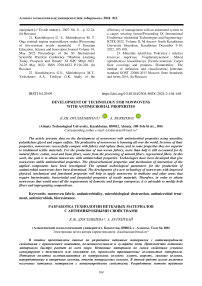Development of technology for nonwovens with antimicrobial properties
Автор: Dyussenbiyeva K.Zh., Burkitbay A.
Журнал: Вестник Алматинского технологического университета @vestnik-atu
Рубрика: Технология текстиля и одежды, дизайн
Статья в выпуске: 2 (144), 2024 года.
Бесплатный доступ
The article presents data on the development of nonwovens with antimicrobial properties using anavidin, polyethylene glycol and copper sulfate. The production of nonwovens is booming all over the world. In terms of their properties, nonwovens successfully compete with fabrics and replace them, and in some properties they are superior to traditional textile materials. For the production of non-woven fabrics, more than half is still accounted for by natural fibers: cotton, wool and linen fibers, waste from the processing of natural fibers, regenerated fibers. In this work, the goal is to obtain nonwovens with antimicrobial properties. Technologies have been developed that give nonwovens stable antimicrobial properties. The physicochemical properties and mechanism of interaction of the applied components have been investigated. The optimal technological parameters for the production of antimicrobial nonwovens have been determined. The development of a new technology of nonwovens with improved physical, mechanical and functional properties will help to apply nonwovens in medicine and other areas that require bacteriostatic, bactericidal and fungicidal properties of textile materials. Therefore, in order to obtain nonwovens that would meet all the requirements of domestic and foreign enterprises, it is advisable to modify both fibers and impregnating compositions.
Nonwoven fabric, antimicrobiality, microbiological destruction, antimicrobial treatment, antimicrobials, bioresistance
Короткий адрес: https://sciup.org/140305882
IDR: 140305882 | УДК: 64.29.09 | DOI: 10.48184/2304-568X-2024-2-164-168
Список литературы Development of technology for nonwovens with antimicrobial properties
- K.S. Huang, H.S. Lian, J.B. Chen, “Study on the modification of PP nonwoven fabric”, Fibres Text. East. Eur., vol. 3, (2011): pp. 82-87,
- D. Gao, R. Zhao, X.Yang, F.Chen, X. Ning, “Bicomponent PLA Nanofiber Nonwovens as Highly Efficient Filtration Media for Particulate Pollutants and Pathogens”. Membranes. 11(11), (2021): r.819.
- H.Qiu, Z.Si, Y.Luo, P.Feng, X.Wu, W.Hou, Y.Zhu, M.B.Chan-Park, Xu L, D. Huang, “The Mechanisms and the Applications of Antibacterial Polymers in Surface Modification on Medical Devices”, Front. Bioeng. Biotechnol. 8, (2020): r.910.
- Egorkina E.A. Novyi podkhod k resheniyu starykh problem v oblasti meditsiny i zdravookhraneniya v Rossii // Zh. Kur'er, 2005. №1. - S. 9-11.
- GOST 11680-76. Tkani byazevoi gruppy. Tekhnicheskie usloviya.
- GOST 7138-83. Tkani khlopchatobumazhnye mitkalevoi gruppy. Tekhnicheskie usloviya.
- GOST 10138-93. Tkani chistol'nyanye, l'nyanye i polul'nyanye bel'evye (dlya postel'nogo i natel'nogo bel'ya). Tekhnicheskie usloviya.
- E.W. Moon, H.-.W. Lee, J.H. Rok, J.-.H. Ha, “Photocatalytic inactivation of viral particles of human norovirus by Cu-doped TiO2 non-woven fabric under UVA-LED wavelengths”, Science of the Total Environment, vol. 749, (2020): p. 9.
- I. Cerkez, S.D. Worley, R.M. Broughton, T.S. Huang, “Antimicrobial surface coatings for polypropylene nonwoven fabrics”, Reactive and Functional Polymers, vol. 73 (11), (2013): pp. 1412-1419.
- S. Kim, Y. Cho, C.H Park, “Effect of cotton fabric properties on fiber release and marine biodegradation”, Text. Res. J. 92, (2022): rr. 2121-2137.
- C. Deng, F. Seidi, Q.Yong, X. Jin, C. Li, X. Zhang, J.Han, Y. Liu, Y.Huang, Y.Wang, “Antiviral/antibacterial biodegradable cellulose nonwovens as environmentally friendly and bioprotective materials with potential to minimize microplastic pollution”, J. Hazard. Mater. 424, (2021): 127391.
- S. Smith, M.Ozturk, M. Frey, “Soil biodegradation of cotton fabrics treated with common finishes”, Cellulose, 28, (2021): rr. 4485-4494.
- Dyusenbieva K.Zh., Aitulova B.T. Maқta matalaryna antimikrobtyқ қasiet beru. Materialy respublikanskoi nauchno-prakticheskoi konferentsii molodykh uchenykh «Nauka. Obrazovanie. Molodezh'», // Almaty, 26 -27 aprelya 2018 g., - S. 148-149.
- Bektemisova N.Kh., student 4 kursa., Dyusenbieva K.Zh, Rashidova B.R. Toқyma materialdaryn biologiyalyқ zaқymdanudan қorғau. Materialy Respublikanskoi nauchno-prakticheskoi konferentsii molodykh uchenykh «Nauka. Obrazovanie. Molodezh'», Almaty, 21-22 aprelya 2022 g. - S. 87-89.
- GOST 9.060-75. Metod laboratornykh ispytanii na ustoichivost' k mikrobiologicheskomu razrusheniyu.
- GOST 10550-93. Materialy tekstil'nye. Polotna. Metody opredeleniya zhestkosti pri izgibe.
- GOST 12023-93. Materialy tekstil'nye. Polotna. Metody opredeleniya tolshchiny.


